Welcome back to our last and final segment on Freestyle Rotation. As we discussed in Part’s I and II– there is definitely pros and cons to both rotating and not rotating during the Freestyle stroke. Our goal today is to give YOU the answer(s) on what to do with your Freestyle stroke.
In case you missed Part I or Part II of this series, here are the links to access them:
Part I–[CLICK HERE]
Part II–[CLICK HERE]
Just like everything with swimming technique, there is NO one size fits all recipe for swimming fast. Whether or not you rotate in Freestyle should be seen the same way. While, there’s definitely a few questions to answer when it comes to rotating in Freestyle—all of these points should be answered by EACH coach and swimmer before changing your current stroke. Let’s dig into them:
1.) What Type of Freestyler are YOU?

The easiest way to think of this is by your race distance. Obviously, we discussed that a flatter Freestyle generates a higher tempo, so if you’re a mile swimmer—a high tempo would not be what you’re going for.
A sprinter on the other hand—you definitely want a higher tempo, so swimming flatter would be more beneficial for you, as you really ramp up your stroke rate.
2.) What HAPPENS to Your Stroke When You Rotate LESS?

The goal of less rotation is for a swimmer to get into their catch sooner, so they can start moving water backwards faster and more frequently. If you feel like you’re slipping or not really getting any advantage from swimming flatter, don’t do it.
This is especially true for some master athletes and swimmers who have been the water for a long time. If your normal, original stroke is rotation-based–swimming flatter may change your stroke mechanics and affect your times.
Definitely consult with your coach if you suspect any slipping is happening. If not, at Swim Like A. Fish we offer video analysis packages where you get 1:1 Technique Coaching with ME! [CLICK HERE] to learn more.
3.) What HAPPENS When You Rotate MORE?

If you’re not used to rotating, you will increase your distance to push water backwards—just like we mentioned in Part I of this series.
Also, if you do over-rotate—so rotate even more than you should, which the ideal amount of rotation in Freestyle does NOT exceed 30-degrees to the water’s surface—you may swim a little side-to-side. It IS possible to swim more than 25 meters or yards per lap—especially, if you are spending time moving laterally, not just longitudinally.
4.) Over-Rotation Also AFFECTS Your Legs, WHY?

If you have a tendency to over rotate, you also are swinging your legs too much side-to-side. As discussed in our Freestyle kicking series, the only part of the Freestyle kick that moves a swimmer forward is when the top of the feet/shins are kicking down (and backwards). This is the “finish” portion of the down-kick. All other parts of the kick—up-kick, transition, and knee bend help a swimmer have a more effective down-kick.
With over rotation, you will spend more time kicking water in tons of different directions—as opposed to backwards and down—which doesn’t help a swimmer swim faster either.
5.) If You Rotate MORE, You Better LOVE Kicking!

Since you spend more time in the recovery phase of the Freestyle stroke, a more rotated stroke requires a swimmer to depend more on their legs to generate propulsion.
This means all throughout the recovery, the extension, entry, and into the catch—a swimmer will need their legs to be the powerhouse moving them down the pool to offset the extra time spent in the non-propulsive phases.

This is the only question, that I would say it pretty easy to assess. If you can’t kick fast, and aren’t a fan of kick sets—a heavily rotated Freestyle stroke is NOT for you
Thanks for tuning in to this series.
Until Next Time,
Abbie Fish

3 Responses
All three episodes were instructive
Thank you
you’re welcome!